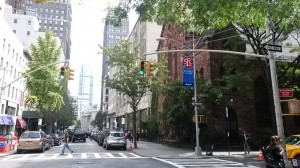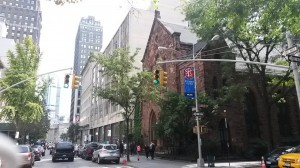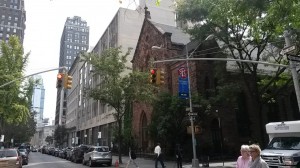In the city of New York, there are many aspects that are considered to be from the “Old New York” or the “Present day New York”. The combination of the two are what make up the very culture of New York. From the sky scrapers down town, to the man made residents from a nearby neighborhood, they each hold their own story. The location that I have chosen is fifteen minutes away from City Tech, and is on the intersection of Clinton and Remsen street. At this location I discovered an example of a juxtaposition between the two New Yorks. It was as if I was standing before the timeline of the city, viewing two different stages of time.
In order to reach the destination, I decided to leave through the main entrance on 300 Jay street. This would be my starting position. Across the street is a construction site in progress. Up the block is a station of city bikes on racks. I walked in the direction of the city bikes and turned right onto the first intersected on Johnson street. I walked passed the school’s cafe and crossed Adams street which leads to the Brooklyn Bridge. I soon approached the intersection of Johnson street and Court street. As I walked south on Court street I could see Columbus park on my left. This area consists of the Supreme court and the Borough Hall station for the 2,3,4,5, and R train. To my right was the New York sports club store. I decided to walk down the block of this store on Remsen street. On this block was the St. Francis college populated by dozens of students in front of the entrance. I walked to the end of the block and stopped at the intersection of Clinton and Remsen street. At this moment I looked back up the block and realized I had found my juxtaposition that I could potentially use. I had to find my position in the street to catch a suitable picture frame.
I consider my juxtaposition unique because I found it in the most unexpected place. It was sort of a planned mistake. I framed my picture in the intersection of Clinton and Remsen street. After physically standing in the road for a few minutes, I got a few good pictures and moved out the way of traffic. When someone first looks at the picture, they may not see my see my juxtaposition immediately. This juxtaposition entails an old church building to the right of the frame and a sky scraper in the far distance. The church has a pointed roof with black fences that circle the whole property. From what I could see, the outer material mainly consists of large brownish bricks. During the time this structure was built, there may not have been any construction materials that helped along with the process as there are today. It may have been built using a similar technique that the Incas used to make their own homes. This technique consisted of shaving down large rocks (using harder rocks) into the form of bricks. Each one would have to be the same size with clean straight edges in order to fit into place with the others. This process is repeated until a stable wall is built and held together using a glue like substance. The windows of this church may also hold their own story. These windows are known as stained glass windows because each one has an artistic image relating to the religion of the church. In this case you may see images of Mary holding baby Jesus, Jesus on a cross etc. In structures today, it is not likely you will find these kind of details that define it. From the outside it may seem as if there is more than one floor because the windows continue up in a second row. However, these structures simply have a high roof that go up to a pointed center. Based on the aspects of this building, I was able to determine that it was from an old New York.
In the distance, the second portion of my juxtaposition consist of a silver skyscraper reaching for the clouds. Unlike the church, this structure had hundreds of floors that allow you to see over the city. This is possible because in the new New York, we have access to tools and materials such as cranes, more metal, stronger glass, and even helicopters to put parts in place. The process to creating the master piece from the blue prints would be quicker to that of the church because of the helping hand of technology. It had a sleek glassy design that glistened in the suns light. At first sight I felt a futuristic vibe from the building. Its corners had sharper angles, and its smooth exterior would allow precipitation to race down the face of the windows with ease. After observing this juxtaposition I realized a sense of symbolism. Knowing that the church building represents the old New York, it represents the past as we know it. After following the road to its vanishing point,one can see the sky scraper in the center. I believe that this could symbolize the path to innovation, new ideas, and advancement from the old New York, to the new New York.
I chose this subject in particular because it pinpoints two completely different time periods of New York and brings them together into one frame. From the image I captured, I was able to see where we were as a city (before my time) as well as how far we have come. Over the course of the years the city has changed drastically, but the streets hold the history of what came before. Colson Whitehead supports my concept with what he says in his passage. He states, ” Our streets are like calenders containing who we are and who we will be next”. In this case, the “we” in this quote represents the path or destiny of our city. In this passage, Whitehead conveys the concept that the streets of the city record everything that happens and endures what will result from this as the new New York begins to emerge. My juxtaposition fits the concept that Whitehead brings across. As we know, the old church building in the photo is of the old New York representing who we once were. The photo also depicts Remsen street which leads to a single vanishing point pointing up to the sky scraper which is an achievement.
Whitehead also explains the concept of the overlap between the two cities. In the last paragraph of the passage he states, “What follows is my city, making it a guide book……It contains your neighborhood. Or doesn’t. We overlap. Or don’t. Maybe you’ve walked these avenues. Maybe it’s all Jersey to you”. I found this intriguing because it explains that the two different New Yorks are like a ” guide book” and the new New York is the latest city to be built onto what came before. He seems to be undecided at whether these New Yorks overlap or not. He tries to connect or relate to everyone who knows the city. This may be because a particular individuals version of New york my have been demolished, or lost in time and no longer exists. But the reality is that most overlaps will always exist as long as the city begins to evolve. Therefore, this quote supports what my juxtaposition represents.
Overall, my juxtaposition depicts the proper overlap between the two New Yorks. As time progresses, new overlaps will continue to be created. Whitehead says that we must not fight the inevitable because nothing is meant to last forever. These eight million New Yorks he mentions will never be the same as the one I know or even the one my neighbor knows. But when we look back at the city we have grown to love, we can always spot a particular aspect that we can reminisce on from our own New york.








